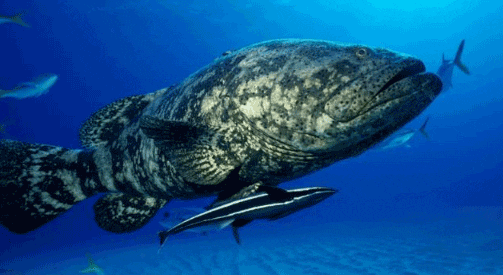
Susceptible to overfishing
Historically, the goliath grouper was relatively common and highly conspicuous in portions of its range. It is a relatively shallow-water species with a tropical to subtropical distribution. In the western Atlantic Ocean goliath grouper are found from Florida to Brazil, including the Gulf of Mexico and the Caribbean Sea. In the Eastern Atlantic they occurred from Senegal south to the Congo; however, this population is believed to have been eliminated because no individuals have been observed there for many years. A similar-looking species also occurs in the Pacific Ocean, but recent genetic studies indicate it is a different species.
While once relatively abundant, the goliath grouper has proven to be vulnerable to fishing pressure. Due to significant declines in abundance through the 1960s-80s, harvest of goliath grouper was prohibited in U.S. waters in 1990.
In 1994, goliath grouper was listed as critically endangered on the International Union for Conservation of Nature Red List of Threatened Species http://www.iucnredlist.org/. The species has since been protected in Brazil (2002), Puerto Rico (2004) and the U.S. Virgin Islands (2004), but fishing continues in other parts of its range.
Following the granting of protected species status, abundance in Florida has appeared to increase over the past two decades, but the extent of the recovery is not clearly understood. Information on historical abundance is limited and not precise. Likewise, information on the perceived increase in abundance is limited, and it is difficult for fisheries managers to truly understand the extent to which the species has recovered throughout its geographic range.
So, what is the problem?
A common perception among anglers and spear-fishing enthusiasts is that large and abundant goliath groupers eat other groupers and snappers, and thus substantially decrease the abundance of the fish that fishermen are targeting. This perception is reinforced by the fact that goliath grouper will opportunistically prey upon hooked or speared fish. Many anglers report that aggressive goliath grouper can make it almost impossible to land a fish. In extreme cases, anglers complain that such activity can make it essentially impossible to fish an area with any hope of successfully bringing legal-sized or even undersized reef fish to the boat.
Recreational divers have expressed concern about human safety as goliath grouper repeatedly exposed to wounded or dead fish can become aggressive, and in extreme cases may harass divers with speared fish. Many anglers and divers are now concerned that the goliath grouper’s protected status has resulted in abundance levels that do not represent a natural ecosystem balance. They believe some harvest would be desirable to reestablish a more natural balance.
Why are goliath grouper vulnerable to harvest?
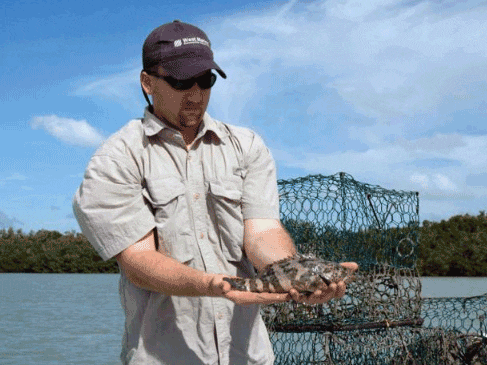
Goliath grouper are relatively long-lived. The maximum known age is 37 years and scientists think they may live to 50 or even 100 years. There are several other reasons why goliath grouper are vulnerable. They are relatively slow growing and take five to seven years to reach sexual maturity. Adult goliath groupers are generally sedentary and have small home ranges, making them more vulnerable to spearfishing. The fact that they form predictable spawning aggregations further increases susceptibility to fishing pressure.
When and where do goliath grouper spawn?
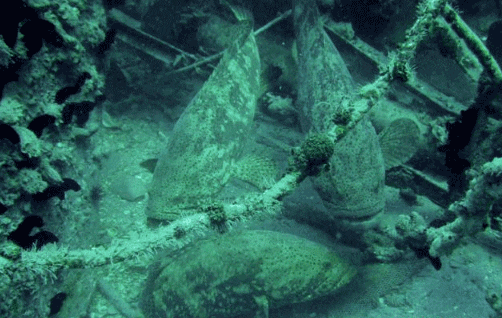
Most of the known spawning aggregations are off southwest Florida, but additional aggregations have recently been observed off Florida’s central east coast. It appears that these spawning sites are relatively constant from year to year and consist of wrecks, rock ledges and isolated patch reefs. These aggregations usually contain less than 100 individuals. Spawning occurs in late summer or early fall and occurs on dark nights (new moon particularly) between 10 p.m. and 3 a.m. Spawning during the darkest nights may represent an adaptation to reducing predation on the eggs. Goliath grouper are dispersal spawners, meaning eggs and sperm are released and mixed in the water column during spawning. The planktonic larval stage lasts for approximately six weeks. Juveniles settle in shallow estuarine habitats, where they reside for several years before moving offshore.
Where is the nursery habitat for goliath grouper?
Mangroves serve as critical nursery habitat, with small, newly settled goliath found first in mangrove leaf litter and then along mangrove shorelines. The Ten Thousand Islands and the Everglades in southwest Florida have been identified as important sources of juvenile recruitment, but other areas in Florida are likely also significant. Juveniles remain in mangrove habitat for the first five to six years of life, and then move offshore when they reach about 3 feet. Abundant food and shelter result in high survival and fairly rapid growth of 4.5-6 inches per year during the juvenile phase. They tend not to move much and usually stay within about 100 yards of the same spot.
How much do they move around?
As with juveniles, adult goliath groupers also have a tendency to remain at one site for extended periods. Many of the tagged adults re-sighted by researchers or reported by anglers were often found in the same location where they were tagged. However, there is also evidence that individuals may move around more than previously believed, because multiple tagged individuals have been observed moving among different wrecks that are many miles apart. Juveniles moving out of mangrove habitat may disperse far and wide until they establish a more permanent home range. One juvenile tagged in the Ten Thousand Islands was recaptured on the central east coast in the Indian River area. Also, adults may move for spawning purposes and migrate up to 100 miles or more to reach spawning aggregation sites.
What do goliath grouper eat? The findings may surprise you!
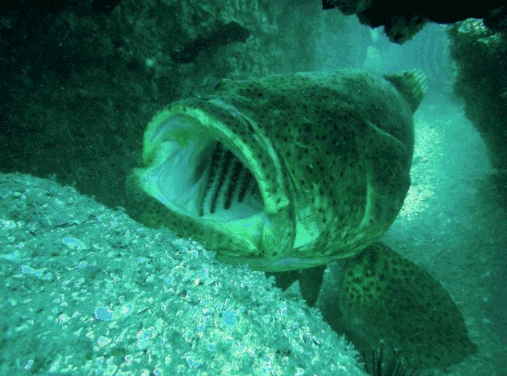
To date, goliath grouper stomach content analysis has documented that about 85% of their diet consists of crustaceans, mostly crabs. The remaining 15% primarily consists of slow-moving fishes such as burrfish, catfish and toad fish. In the stomach contents of more than 200 goliath grouper, no grouper and only a few snapper (about 3%) were found.
Besides looking at stomach contents, which provide just a short-term view of what a grouper has eaten before it is captured, scientists have also examined the grouper’s diet over the long-term using a sophisticated analytical technique called stable isotope analysis. This measures the relative concentration of certain molecules like oxygen and carbon in body tissue to help scientists understand links in the marine food web. Results show that goliath groupers occupy a relatively low position on the food chain, about on the same level as the tiny pinfish, a common baitfish. Thus, the results tend to confirm that goliath grouper do not usually eat high-level predators such as groupers and snappers.
This does not mean that a hungry goliath grouper, as many anglers have experienced, won’t opportunistically go after struggling fish on a line or fish wounded by spear fishing. However, the perception that goliath grouper are consuming healthy groupers and snappers is not supported by scientific evidence. Research published in 2011 (http://www.bio.fsu.edu/coleman_lab/documents/Koenigetal_2011_GG_recover%20(BMS).pdf ) by Florida State University researchers documented that reef fish diversity and abundance is actually higher when goliath grouper are present.
They forage for food during daylight and are mostly inactive during the night. Consequently, the number of goliath grouper observed concentrated over structure during the day may not represent all that are actually present.
How are fishery managers evaluating goliath grouper recovery?
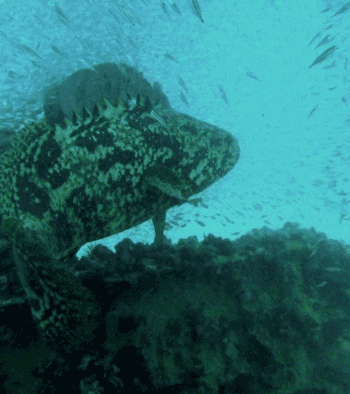
Since protective measures were implemented in 1990, anecdotal accounts and directed research efforts indicate increasing abundance of goliath grouper throughout Florida. The most recent stock assessment (2004) indicated that goliath grouper in Florida waters were recovering, but that the population may not experience full recovery until 2020 or later. Because the harvest of goliath grouper is prohibited, the conclusions of the stock assessment were made in the absence of certain types of biological information (e.g., age structure, sex ratio) that are typically available for other species through the examination of harvested individuals.
These are the types of information that have been used:
- REEF: Most of the current abundance estimates for adults remain limited to Reef Environmental Education Foundation (www.reef.org) survey reports and localized accounts by the fishing and diving communities. Citizen volunteers have played an important role in assessing goliath grouper abundance and locating spawning aggregations. Although useful, these data do not consistently include size distribution or standardized sampling throughout seasons. Additionally, if more than one goliath is observed the exact number of observed fish is often not recorded.
- Everglades National Park Angler Surveys: Detailed catch and effort data collected during volunteer dockside interviews of recreational anglers from within Everglades National Park show a substantial decline in abundance during the late 1970s and early 1980s. Since the moratorium in 1990, the abundance of juveniles within ENP, which includes critical nursery habitat for this species, has increased considerably.
- Florida State University/Coleman and Koenig Laboratory goliath grouper tagging program (www.bio.fsu.edu/coleman_lab/goliath_grouper.php): This program has yielded important information on the movements and distribution of goliath grouper in Florida. Anglers and divers can provide valuable assistance by reporting observations of tagged goliath grouper (see information below).
- Florida Fish and Wildlife Conservation Commission: FWC scientists at the Florida Wildlife Research Institute are currently conducting scuba surveys of goliath grouper abundance and size distribution at specific sites along the central west coast of Florida. Both artificial and natural reefs across a range of depths are surveyed consistently throughout the year, and fish are tagged with ID tags and acoustic tags to help identify movement and site fidelity.
- Plans for future stock assessment: The Florida Fish and Wildlife Conservation Commission conducted a statewide assessment in 2010 and the National Marine Fisheries Service will conduct a more comprehensive assessment in 2014.
How can I help?
Citizen volunteers have played an important role in helping scientists evaluate the recovery of goliath grouper and also in identifying spawning aggregations. The known vulnerability of goliath grouper coupled with a lack of traditional fishery data will make it difficult for fishery managers to consider what level of harvest, if any, can be safely allowed.
You can play a role in the goliath grouper’s recovery and assist scientists in data collection.
Catch-and-Release
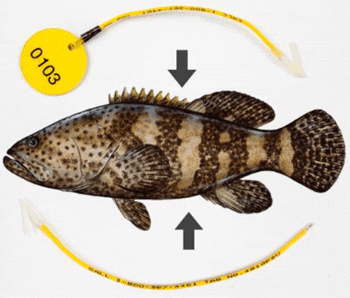
Practice effective catch-and-release techniques (catchandrelease.org) when you fish for goliath grouper. Large goliath grouper should not be brought on board. Their skeletal structure cannot adequately support their weight out of the water without some type of damage. All attempts should be made to remove the hook at the side of the boat with the fish in the water to minimize injury to the fish. Have a venting tool and a de-hooking device at hand. Removing smaller goliath groupers from the water to remove hooks is not necessarily a bad practice, but this process must be done as quickly as possible, using proper fish handling techniques.
Report Tag Numbers
Assist scientists in assessing recovery. A number of adult and juvenile goliath grouper have been tagged in research studies. Adult tags are placed on the fish’s back. The smaller tags used on juveniles are placed on the fish’s belly. Anglers and divers who encounter these fish are asked to report the tag number, sighting location and date of sighting. The hotline number is listed on the tag (1-800-367-4661).
January 2012
